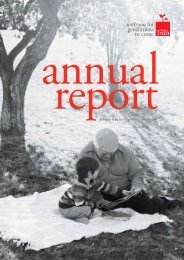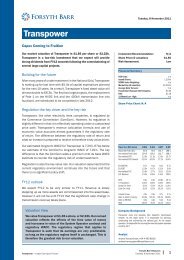Landcorp - Crown Ownership Monitoring Unit
Landcorp - Crown Ownership Monitoring Unit
Landcorp - Crown Ownership Monitoring Unit
- No tags were found...
Create successful ePaper yourself
Turn your PDF publications into a flip-book with our unique Google optimized e-Paper software.
INFORMED FARMINGINFORMED PEST CONTROL CONTINUED“In the end, we know thatthere will not be one silverbullet against manuka beetle.No one control method willwork in all situations, andfarmers will probably dobetter by using two or threemethods in combinationto support their particularpasture types and farminggoals.”with each trapped beetle recorded andexamined to identify species and sex. “There’sa lot of digging and larvae counting … a lot oftrapping adult beetles and examining themunder a microscope,” says Jessica. “We’relooking for the best times to disrupt theirlifecycle … probably in April when the largestnumber of larvae are feeding close to thesoil surface.”As part of the project, <strong>Landcorp</strong> works withAgResearch and a Sustainable Farming Groupof local farmers who have agreed to gatherand share information on the beetle and onpractical responses to the problem. The groupincludes three other private farmers, with afurther three who are regular participants.All are seeking efficient means of manukabeetle control that are preferable to sprayingpastures with organophosphates. The work hasproduced some very promising ideas.ControlsPossible controls include a naturally-occurringfungus that is toxic to the larvae. AgResearchcultivated samples and drilled these into thesoil in selected trial plots. Over four weeks,Jessica studied the impact – and pleasingly, thefungus appeared to infect the larvae and stoptheir growth. Further trials are underway.Other R&D streams put a focus on grass andsoil fertility, <strong>Landcorp</strong> and its partners arelooking for the grasses that are most resistantto manuka beetle while also thriving inWest Coast conditions and having adequatefeed value. AgResearch has undertakenlaboratory trials on various grasses and theSustainable Farming Group has taken thisline of investigation into the field. On CapeFoulwind’s Totara dairy unit, cows will nowbe systematically grazed on different grasses,at different stocking rates. Jessica says a mixof fescue and clover seem hardier and lessattractive to manuka beetle larvae, whichapparently prefer ryegrass. Higher soil fertility,more organic matter and more vigorous grassgrowth could also be part of the answer. Thegroup has trialled different fertiliser regimeson nine paddocks. “The higher the fertility ofthe soil, the thicker the sward of grass andthe harder it is for the beetle to get the upperhand,” says Paul Hateley. “On the other hand,that would be partly a matter of growing somegrass just for the beetle to eat!” One of thecurrent trials involves the spreading of effluenton pasture and monitoring has shown thatpastures treated with effluent appear to havelower numbers of larvae feeding.Stocking rates make a difference as well.The group is exploring the impact of moredense feeding patterns that turn the cowsthemselves into a control mechanism – theycrush the larvae under hoof. Still other workhas focused on the application of slow releaseinsecticides of the kind commonly usedagainst grass grub in other regions of NewZealand. “The results have been encouragingwith visible differences found between treatedand untreated plots,” says Jessica. “In the end,we know that there will not be one silverbullet against manuka beetle. No one controlmethod will work in all situations, and farmerswill probably do better by using two or threemethods in combination to support theirparticular pasture types and farming goals.”Totara Dairy Farm Manager Glen Hooperlooks for signs of beetle infestation in apaddock used for grazing his cross bred herd.Infestation tends to be worse on drier sandy soils below the ridge lines on undulating pasture.Once established in an area, the female setosa beetles lay their eggs close to where they emerged as an adult.This results in an increasing number of brown dead grass patches.34
















